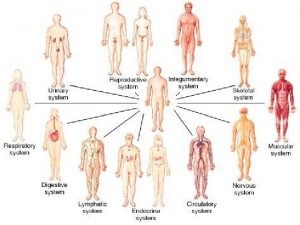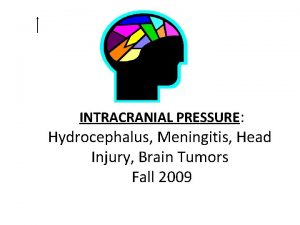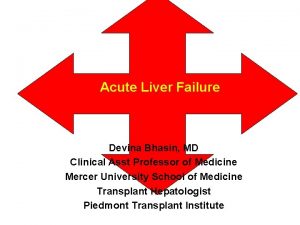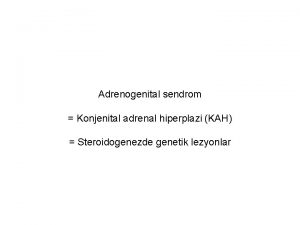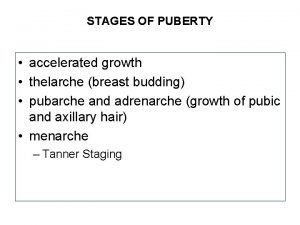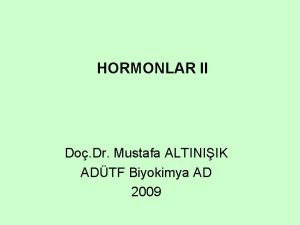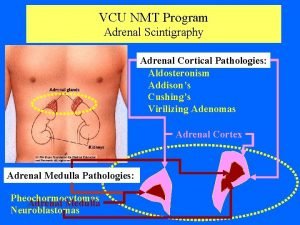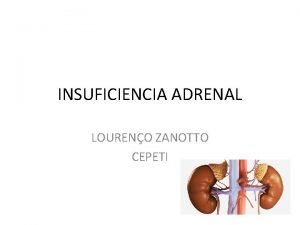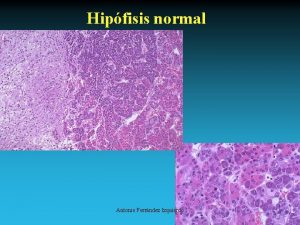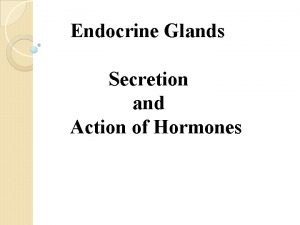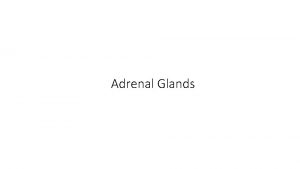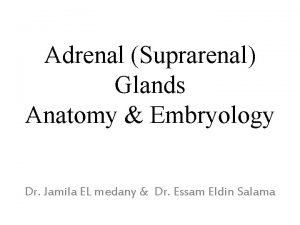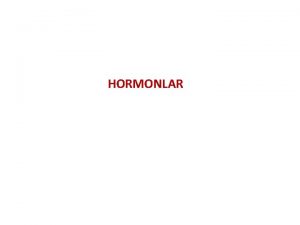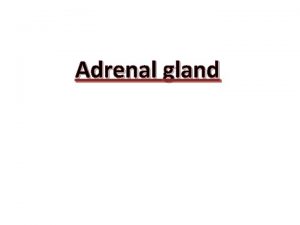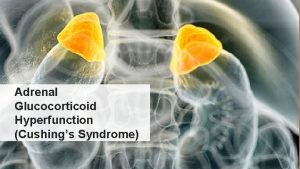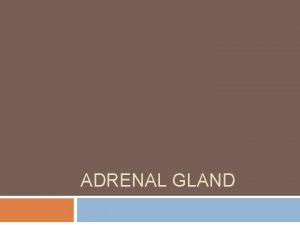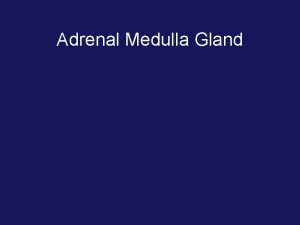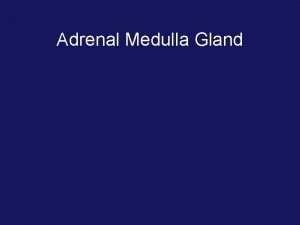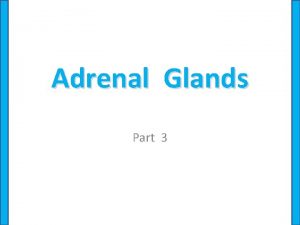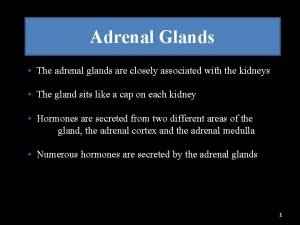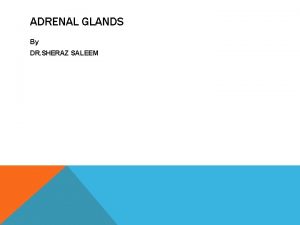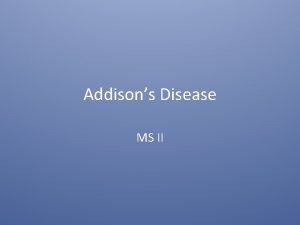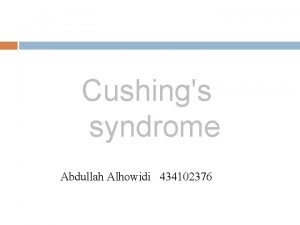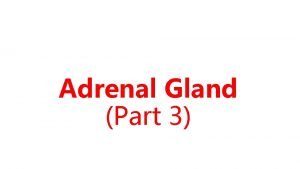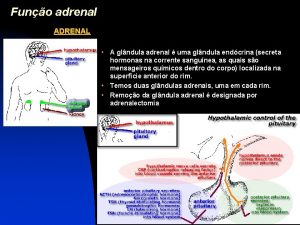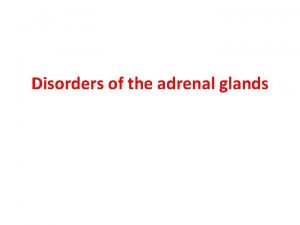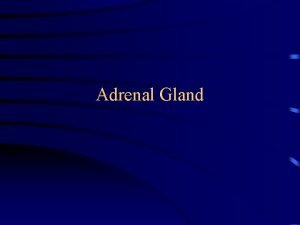DISEASES OF THE ADRENAL GLANDS CUSHINGS DISEASE Hyperadrenocorticism




























- Slides: 28


DISEASES OF THE ADRENAL GLANDS CUSHING’S DISEASE (Hyperadrenocorticism) ADDISON’S DISEASE (Hypoadrenocorticism)

Adrenal Glands

ADRENAL GLANDS mineralocorticoids Glucocorticoids Androgens epinephrine

Physiology Anterior Pituitary Gland releases Adrenocorticotropic hormone (ACTH) ACTH acts on the ADRENAL CORTEX Glucocorticoid hormone Mineralocorticoid hormone Sex hormones (Androgens) Sympathetic Nervous System stimulates the Adrenal medulla > Epinephrine and norepinephrine FIGHT OR FLIGHT RESPONSE ACTIVATED Increase HR, Inc. BP, Dilated air passages, GI function, vasoconstriction

Hormone Functions *** Mineralocorticoids – Aldosterone • • Regulates electrolyte and H 2 O balance Associated with Hypoadrenocorticism/ Addison’s Primarily dogs A decrease is life threatening Glucocorticoids • • • Promote gluconeogenesis Suppress inflammation Suppress immune system Inhibit cartilage growth and development Associated with Hyperadrenocorticism / Cushing’s

Hyperadrenocorticism (Cushing’s Disease) Definition: Disorder caused by harmful effects of high circulating cortisol concentrations on multiple organ systems Systems affected: Renal Skin Cardiovascular Respiratory Endocrine/metabolic Musculoskeletal Nervous Reproductive

Cushing’s Disease Causes: Anterior pituitary lesion (pituitary-dependent disease) – 85% of cases Adrenal tumor (excess cortisol secretion independent of pituitary control) – 1520% of cases Overmedication with glucocorticoids - Iatrogenic

Cushing’s Disease

Cushing’s Disease Bilaterally symmetrical alopecia, pot-belly, pyoderma

Cushing’s Disease signs are slow to develop and usually go unnoticed by owner Clinical Signs: Some are similar to hypothyroidism PU/PD/PP Pot bellied; obese Muscle atrophy and weakness, lethargy, excess panting Bilateral symmetric alopecia; pruritis; pyoderma (↓ immune response) Calcinosis cutis (firm plaques of Ca++ under skin) Abnormal gonadal function (lack of estrus; soft, small testicles)

Cushing’s Disease: Dx Chemistry Panel ↑ ALP, ALT, blood glucose Urinalysis Low USG < 1. 015 due to PU/PD Urine cortisol/creatinine ratios Normal ratio=no Cushing’s Elevated ratio=may be Cushing’s (high levels of cortisol in the urine)

ACTH Stimulation for Hyperadrenocorticism ACTH Stimulation test Normal patients show an increase of plasma cortisol Pituitary dependent disease (excess ACTH release) and Adrenal tumors: 60 -85% show EXAGGERATED cortisol response Does not differentiate between Pituitary tumor and Adrenal tumor ACTH Stimulation Test Procedure Take a baseline blood sample to detect cortisol levels Inject ACTH stimulation gel or liquid Wait two hours and take a post sample to look for a rise in cortisol

Cushing’s Disease: Dx Low-Dose Dexamethasone Suppression Test Draw a blood sample to determine baseline cortisol levels Inject low dose of steroid (goal is to suppress ant. pit [ACTH]) Measure plasma cortisol at 4 & 8 hr later Interpretation: Normal dogs will show decrease in plasma cortisol A Cushingoid animal will not show any decrease of cortisol at 8 hr

Cushing’s Disease: Dx High-Dose Dexamethasone Suppression Test (used to differentiate between Pit Dis and Adrenal tumor) Collect plasma cortisol at 0, 4, and 8 h Interpretation: Pituitary dependent disease— 70 -75% will show decrease of cortisol at 4 or 8 h Adrenal tumor—no decrease in plasma cortisol level because tumor is autonomous

Cushing’s Disease: Rx Surgical removal Adrenal tumor - Specialized surgery; most vets would refer surgery Pituitary tumors are not surgically removed Medical treatment Lysodren (mitotane)—necrosis of zona fasiculata, zona reticularis repeat ACTH stimulation q 7 -10 d until cortisol normal excess dose affects zona glomerulosa (Addison’s Dis)

Cushing’s Disease: Rx Medical management Vetoryl®(trilostane): less side-effects than mitotane interferes with cortisol production (doesn’t kill cells)

Cushing’s Disease: Client info Client Info Serious disease; life-long treatment Periodic monitoring required Addison’s disease may result from treatment Prognosis: average life expectancy is 20 -30 mo on therapy with frequent recurrence of clinical symptoms

FIND YOUR PURPSOSE! “The two most important days of your life are the day you were born and the day you find out WHY. ” -Mark Twain

Addison’s Disease (Hypoadrenocorticism) Definition: Disorder caused by deficient production of glucocorticoids (cortisol) or mineralocorticoids (aldosterone) or both Iatrogenic disease caused by chronic administration of corticosteroids followed by sudden cessation

Addison’s Disease (Hypoadrenocorticism) Clinical Signs: lethargy, weakness, anorexia, wt. loss Vomiting/Diarrhea PU/PD, dehydration Bradycardia

Addison’s Disease Pathophysiology Decreased aldosterone => decreased retention of Na=> decreased blood volume =>hypotension, dehydration, azotemia Hyperkalemia affects the heart => bradycardia Glucocorticoid deficiency => vomiting, diarrhea, melena, lethargy, wt. loss, hypoglycemia

Addison’s Disease: Dx Chemistry Panel Na: K ratio <25: 1!(normal=27: 1 to 40: 1) ACTH Stimulation test (definitive test) normal dog= ↑ cortisol hypoadrenocorticism dog= low, unchanged cortisol level Test Endogenous ACTH - will be increased due to lack of neg. feedback

Addison’s Disease Example Chem Panel (What is not normal? ) Parameter Value BUN 81 mg/dl Creatinine 2. 1 mg/dl Sodium 131 meq/L Potassium Na: K ratio 20 6. 5 meq/L Normal value 7 -27 mg/dl 0. 4 -1. 8 mg/dl 141 -156 meq/L 4. 0 -5. 6 meq/L 27 -40

Addison’s Disease ACTH Stimulation Test Results Value Normal Plasma Cortisol Pre-ACTH 0. 2 2 -6 Post-ACTH 0. 3 6 -18

Addison’s Disease: Rx Acute Crisis may be life-threatening situation Normal saline IV low Na+ is hallmark finding of Addison’s Glucocorticoid replacement cortisol will also be low Dexamethasone or Prednisone IV or IM Mineralocorcorticoid replacement Florinef® (fludrocortisone acetate) - PO Percortin-V (desoxycorticosterone pivalate) injection

Addison’s disease: Rx Chronic Management Glucocorticoid replacement Prednisone Mineralocorcorticoid replacement Florinef® (fludrocortisone acetate) - PO daily Percortin-V (desoxycorticosterone pivalate) – inj. given ~monthly Monitor electrolytes, BUN/Creatinine, clinical signs

Addison’s disease: Client info Mineralocorticoid deficiency is life-threatening Animal requires periodic blood tests Always remind attending vet of pet’s condition Hormone replacement therapy continued for life of pet Prognosis: Good to excellent after stabilization and treatment
 Adrenal glands
Adrenal glands Human body systems images
Human body systems images Merocrine glands vs apocrine glands
Merocrine glands vs apocrine glands Cushing reflex
Cushing reflex Cushings reflex
Cushings reflex Hydrocephus
Hydrocephus Cushings triad
Cushings triad Communicable disease and non communicable disease
Communicable disease and non communicable disease Levotironina
Levotironina Objectives for stress management
Objectives for stress management Dişi psödohermafroditizm nedir
Dişi psödohermafroditizm nedir Psammoma bodies
Psammoma bodies Adrenal cortex develops from
Adrenal cortex develops from Congenital adrenal hyperplasia characteristics
Congenital adrenal hyperplasia characteristics Kolekalsiferol
Kolekalsiferol Adrenal gland regions
Adrenal gland regions Adrenal cushing
Adrenal cushing Arritimias
Arritimias Adenoma
Adenoma Cow adrenal gland
Cow adrenal gland Glucocorticoids
Glucocorticoids Nursing management of adrenal tumor
Nursing management of adrenal tumor The adrenal medullae secrete
The adrenal medullae secrete Hipotiroidismo congénito primario
Hipotiroidismo congénito primario Relations of suprarenal gland
Relations of suprarenal gland Adrenal sympathetic pathway
Adrenal sympathetic pathway Acth
Acth Dr wilson adrenal rebuilder side effects
Dr wilson adrenal rebuilder side effects Pankreas öz suyunda bulunan enzimler
Pankreas öz suyunda bulunan enzimler

